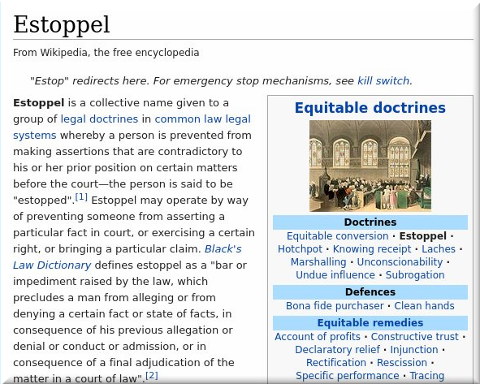

Reference: Estoppel at Wikipedia
"The case involves Synopsys, which now owns the nefarious, Microsoft-connected Black Duck."This is a potentially dangerous decision. Cascading menus are nothing new and to uphold a patent on those would open the floodgates to all sorts of trivial lawsuits (like Apple's "slide to unlock").
Recently, CAFC also looked at the case of patent assignor Hsiun (mentioned here before). The case involves Synopsys, which now owns the nefarious, Microsoft-connected Black Duck. The case is about assignor estoppel and it was mentioned by Patently-O a few days ago. As a bit of background:
EVE-USA was founded by former employees of Mentor — the named inventors on Mentor’s emulation software patents. Initially Mentor licensed the patents to EVE for its use, but that license was terminated when Synopsys later acquired EVE. Mentor then sued Synopsys and won a $36 million jury verdict for infringement of its U.S. Patent No. 6,240,376. Following the Federal Circuit’s decision largely supporting the verdict, EVE/Synopsis have petitioned the Supreme Court for writ of certiorari asking two questions relating respectively to Assignor Estoppel and Apportionment of Damages.
"The patent microcosm generally wants patents to get more 'teeth' at SCOTUS.""Can a patent holder collect lost-profit damages if infringement of a US patent occurs abroad? The US Supreme Court will decide in WesternGeco v Ion Geophysical," Managing IP wrote. This may have an impact on trade, e.g. with China.
Going back to CAFC, there's the Arthrex patent (8,821,541) which CAFC recently decided on. PTAB was supported by CAFC (as usual) and Dennis Crouch wrote about the estoppel (it's an edge case at CAFC). To quote:
The dispute in this case is about what should happen when a patentee disclaims its patent claims prior to an inter partes review institution decision. The Arthrex patent at issue is U.S. Patent No. 8,821,541 which covers a suture anchor — similar to a dry-wall anchor, but sticks into flesh.
After Smith & Nephew filed its IPR petition Arthrex disclaimed the challenged claims. PTO rules state that “No inter partes review will be instituted based on disclaimed claims.” 37 C.F.R. €§ 42.107(e). And, following the rule, the PTAB (acting pre-institution on in the shoes of the PTO director) terminated the petition without instituting the IPR.
Ex Parte Barrego, APPEAL 2016-006527 (PTAB January 2018). Barrego’s claim is directed to a roofing underlay with a number of features including “a pattern having the appearance of a shingled roof printed on at least one surface of the underlayment.” Here, the PTAB affirmed the indefiniteness rejection — finding that “one of ordinary skill would [not] be able to determine definitely whether many particular underlayment patterns do or do not have the appearance of a shingled roof.”
"Unfortunately, the patent microcosm relies on legalese to keep technical people out of the discussion, thus uninvolved or apathetic."This is actually a good thing, but not for the patent microcosm. Watchtroll just continues its ritualistic attacks on the integrity of PTAB (in order to help patent trolls) and although it habitually publishes something worth reading (e.g. [1, 2]) the site is polluted with ads, press releases and even pure puff pieces (like this borderline marketing from Dan Ovanezian and Scott Breining); no depth, classic fluff. We have chosen to keep an eye on Watchtroll (especially because of its attacks on PTAB and CAFC judges), but we prefer not to entertain it too much.
Unfortunately, the patent microcosm relies on legalese to keep technical people out of the discussion, thus uninvolved or apathetic. This is a problem we have been mentioning for years. Sadly, we need to adopt some of their own (often misleading) terms. It has become essential for communication. ⬆